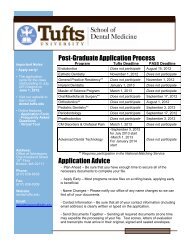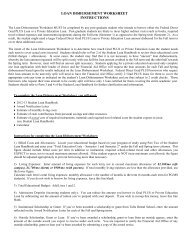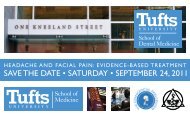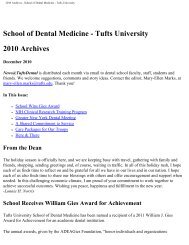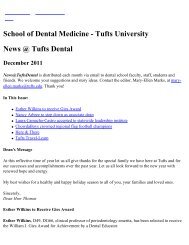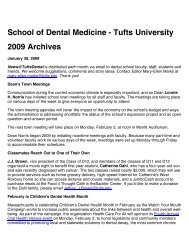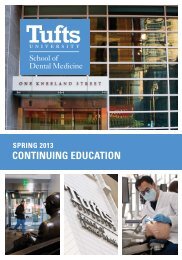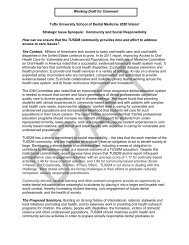Spring 2013 - Tufts University School of Dental Medicine
Spring 2013 - Tufts University School of Dental Medicine
Spring 2013 - Tufts University School of Dental Medicine
Create successful ePaper yourself
Turn your PDF publications into a flip-book with our unique Google optimized e-Paper software.
actively engaged pr<strong>of</strong>essionals, they really<br />
value their time, want time <strong>of</strong>f together.”<br />
When Nicholas Miller, D08, graduated<br />
from <strong>Tufts</strong>, he wasn’t sure whether he wanted<br />
to stay in the Boston area or return to his<br />
native Michigan. Either way, he needed a job.<br />
Through another <strong>Tufts</strong> alumnus, he got in<br />
touch with the Aspen <strong>Dental</strong> chain.<br />
“I was very honest with them about what<br />
my goals were,” says Miller. Among them<br />
was a steady income that would allow him<br />
to start paying back his loans while living<br />
a comfortable life. Working as an associate<br />
moving among three Aspen <strong>of</strong>fices in suburban<br />
Boston, he was able to do just that.<br />
When he returned to Michigan in 2010<br />
and started looking into buying his own<br />
practice, he weighed the choice <strong>of</strong> setting<br />
out on his own, or buying into the Aspen<br />
network. With private practices in the<br />
Grand Rapids area running anywhere from<br />
$400,000 to $1 million, Miller says, “I think<br />
it’s fair to say that Aspen’s price was two to<br />
three times less than purchasing a private<br />
<strong>of</strong>fice with comparable revenue.” Aspen also<br />
helped provide an attractive financing package<br />
through an outside lender, he said.<br />
In July 2010, Miller purchased an existing<br />
Aspen <strong>of</strong>fice. In the three years since,<br />
he bought another existing <strong>of</strong>fice and a<br />
start-up. “I manage the<br />
clinical end, and Aspen<br />
manages the business,”<br />
he says. “I own the dental<br />
practices and, along with<br />
my team <strong>of</strong> dentists, make<br />
all the clinical decisions in<br />
our <strong>of</strong>fices. What Aspen<br />
provides is the business<br />
framework—pr<strong>of</strong>essional<br />
training, accounting services,<br />
marketing strategy,<br />
insurance operations,<br />
facilities management,<br />
human resources, at my discretion.<br />
“It has given me work-life balance. I am<br />
able to go to work and concentrate on my<br />
patients and not worry about making sure<br />
that the mortgage payment is sent out or<br />
ordering supplies. Then I can go home and<br />
continue to have a life.”<br />
Those feelings are shared by dentists<br />
further along in their careers, too. “I like<br />
to pick and choose my headaches,” says<br />
Girschek, <strong>of</strong> Gentle <strong>Dental</strong>. “The older I get,<br />
the more quality <strong>of</strong> life is important.”<br />
Goldberg, the periodontist, says, “One<br />
<strong>of</strong> the things that stresses dentists out” is<br />
getting stuck on how to handle a difficult<br />
clinical case. “In a group practice, when<br />
you have the benefit <strong>of</strong> specialists working<br />
with you, the whole thing is more synergistic—you<br />
have more minds working on the<br />
same problem.”<br />
R<br />
ecently, more private equity<br />
firms and other corporate entities<br />
have invested in dental<br />
chains because their rapid growth makes<br />
them attractive in a sluggish economy.<br />
Some <strong>of</strong> these companies have come under<br />
scrutiny by various state and federal regulators<br />
regarding the extent to which the nondentist<br />
investors are involved in clinical<br />
decision-making, or, in some cases, in connection<br />
with Medicaid abuses.<br />
Perhaps publicity from those cases has,<br />
to some extent, cast a shadow over the entire<br />
segment <strong>of</strong> the industry—unfairly so, say<br />
O’Loughlin, <strong>of</strong> the ADA, and others.<br />
“You can’t generalize that that behavior<br />
happens just in corporate practices,”<br />
O’Loughlin says. “It happens anywhere people<br />
are not following the rules. It’s important<br />
people don’t make broad assumptions.<br />
If you’ve seen one DMSO [dental services<br />
management organization], you’ve seen one<br />
DMSO. Members <strong>of</strong> ADA agree to adhere<br />
to the ADA Code <strong>of</strong> Ethics that puts the<br />
patient’s best interest at the center <strong>of</strong> the<br />
doctor-patient relationship, and that code<br />
holds for an ADA member regardless <strong>of</strong> his<br />
or her career path,” she says.<br />
Miller, the Aspen owner in Michigan,<br />
says it’s important to confront such assumptions.<br />
“Sometimes dental service organizations,<br />
they do have a stigma,” he says. Both<br />
he and Pedram, <strong>of</strong> Pacific <strong>Dental</strong>, stress that<br />
they oversee all clinical decisions in their<br />
<strong>of</strong>fices. “I have complete autonomy,” Miller<br />
says. “Aspen has never told me how to treat<br />
a patient.”<br />
Another assumption, says Shames, <strong>of</strong><br />
Gentle <strong>Dental</strong>, is that large groups place<br />
inordinate pressure on their dentists to<br />
perform procedures to generate revenue.<br />
Private practice owners, he points out, aren’t<br />
immune to that. “If you buy a practice for<br />
$800,000 and have payroll to meet every<br />
week and rent and loans to repay, there is<br />
much more pressure to produce,” he says.<br />
Traditionally, large chains have seen<br />
high turnover, as young dentists gain<br />
experience and go <strong>of</strong>f to establish their<br />
own practices. Whether that will change<br />
in this fluid economic climate is unknown.<br />
O’Loughlin says the ADA is interested in<br />
collecting more data about turnover rates<br />
as well as other aspects <strong>of</strong> the large group<br />
practice phenomenon.<br />
Pedram, who splits his time between<br />
working at Pacific <strong>Dental</strong> and as an associate<br />
in a private pediatric practice, says his<br />
“<br />
americans want everything under one<br />
rooF. they don’t want to leave target to<br />
buy their groceries, and they don’t want<br />
to bounce From a general dentist to an<br />
endodontist to an oral surgeon.<br />
”<br />
—Samuel Shames, D75<br />
dual experience has allowed him to assess<br />
the benefits and drawbacks <strong>of</strong> each. While<br />
he’s not sure what direction he’ll go in, he<br />
makes this observation: “In a few years, if<br />
I finally want to open my own practice, the<br />
way it’s going now, competing against these<br />
corporations is going to be tough.” tDm<br />
Helene Ragovin, the editor <strong>of</strong> this magazine,<br />
can be reached at helene.ragovin@tufts.edu.<br />
spring <strong>2013</strong> tufts dental medicine 17



